Pentax Optio MX User Manual
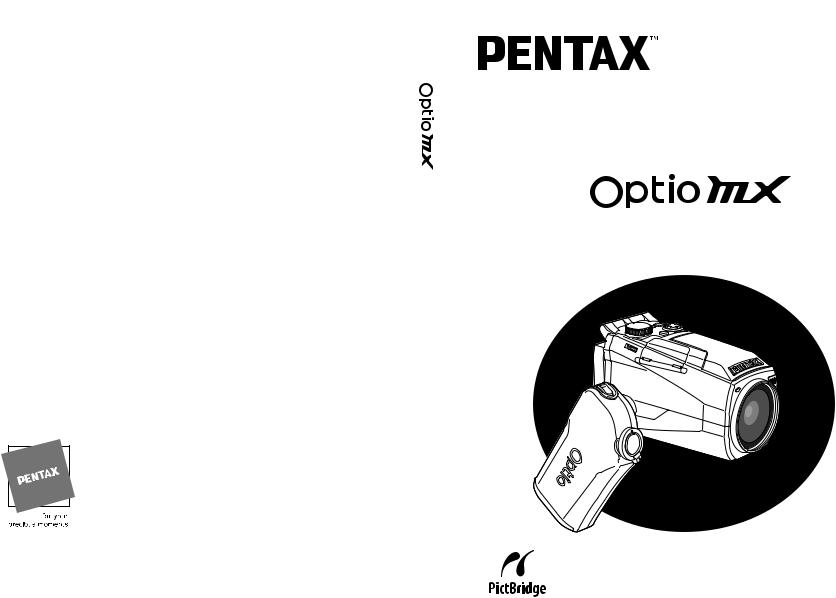
PENTAX Corporation 2-36-9,Maeno-cho, Itabashi-ku, Tokyo 174-8639, JAPAN (http://www.pentax.co.jp/)
PENTAX Europe GmbH (European Headquarters)
Julius-Vosseler-Strasse, 104, 22527 Hamburg, GERMANY (HQ - http://www.pentaxeurope.com)
(Germany - http://www.pentax.de)
PENTAX U.K. Limited PENTAX House, Heron Drive, Langley, Slough, Berks SL3 8PN, U.K.
(http://www.pentax.co.uk)
PENTAX France S.A.S. 12/14, rue Jean Poulmarch, 95106 Argenteuil Cedex, FRANCE
PENTAX Benelux B.V. (for Netherlands)
Spinveld 25, 4815 HR Breda, NETHERLANDS (http://www.pentax.nl)
(for Belgium & Luxembourg)
Weiveldlaan 3-5, 1930 Zaventem, BELGIUM (http://www.pentax.be)
PENTAX (Schweiz) AG Widenholzstrasse 1 Postfach 367 8305 Dietlikon, SWITZERLAND (http://www.pentax.ch)
PENTAX Scandinavia AB P.O. Box 650, 75127 Uppsala, SWEDEN (http://www.pentax.se)
PENTAX Imaging Company
A Division of PENTAX of America, Inc.
600 12th Street, Suite 300 Golden, Colorado 80401, U.S.A. (http://www.pentax.com)
PENTAX Canada Inc. 1770 Argentia Road Mississauga, Ontario L5N 3S7, CANADA
(http://www.pentaxcanada.ca)
http://www.digital.pentax.co.jp
•Printed on recycled paper
•Specifications and external dimensions are subject to change without notice.
57367 |
Copyright © PENTAX Corporation 2004 |
|
|
03-200406 Printed in Japan |
|
|
|
|
|
|
|
Digital Camera
Operating Manual
To ensure the best performance from your camera, please read the Operating Manual before using the camera.

Thank you for buying the PENTAX Optio MX Digital Camera.
Please read this manual before using the camera in order to get the most out of all the features and functions. Keep this manual safe, as it can be a valuable tool in helping you to understand all the camera’s capabilities.
Regarding copyrights
Images taken using the Optio MX that are for anything other than personal enjoyment cannot be used without permission according to the rights as specified in the Copyright Act. Please take care, as there are even cases where limitations are placed on taking pictures even for personal enjoyment during demonstrations, industrial enterprise or as items for display. Images taken with the purpose of obtaining copyrights also cannot be used outside the scope of use of the copyright as laid out in the Copyright Act, and care should be taken here also.
To users of this camera
•There is a possibility that recorded data may be erased or that the camera may not function correctly when used in surroundings such as installations generating strong electromagnetic radiation or magnetic fields.
•The liquid crystal panel used in the LCD display is manufactured using extremely high precision technology. Although the level of functioning pixels is 99.99% or better, you should be aware that 0.01% or fewer of the pixels may not illuminate or may illuminate when they should not. However, this has no effect on the recorded image.
Regarding trademarks
•The SD logo 
 is a trademark.
is a trademark.
•PENTAX is a trademark of PENTAX Corporation.
•Optio is a trademark of PENTAX Corporation.
•All other brands or product names are trademarks or registered trademarks of their respective companies.
•This product supports PRINT Image Matching II.
•When used in combination, PRINT Image Matching II enables digital still cameras, printers and software help photographers to produce images more faithful to their intentions.
Copyright 2001 Seiko Epson Corporation. All Rights Reserved. PRINT Image Matching II is a trademark of Seiko Epson Corporation.
•PictBridge allows the user to connect the printer and digital camera directly, using the unified standard for the direct printout of images. You can print images directly from the camera through a few simple operations.
•There is a possibility that the illustrations and the display screen of the LCD monitor in this manual are different form the actual product.
Declaration of Conformity
According to 47CFR, Parts 2 and 15 for
Class B Personal Computers and Peripherals
We: |
PENTAX Imaging Company |
|
A Division of PENTAX of America, Inc. |
Located at: 600 12th Street, Suite 300 Golden, Colorado 80401 U.S.A.
Phone: 303-799-8000 FAX: 303-790-1131
Declare under sole responsibility that the product identified herein complies with 47CFR Parts 2 and 15 of the FCC rules as a Class B digital device. Each product marketed is identical to the representative unit tested and found to be compliant with the standards. Records maintained continue to reflect the equipment being produced can be expected to be within the variation accepted, due to quantity production and testing on the statistical basis as required by 47CFR §2.909. Operation is subject to the following two conditions: (1) This device may not cause harmful interference, and (2) This device must accept any interference received, including interference that may cause undesired operation. The above named party is responsible for ensuring that the equipment complies with the standards of 47CFR §15.101 to §15.109.
Product Name: PENTAX Digital Still Camera
Model Number: Optio MX
Contact person: Customer Service Manager
Date and Place: May, 2004, Colorado

FOR SAFE USE OF YOUR CAMERA
Sufficient attention has been paid to the safety of this product but please pay particular attention to the warnings indicated by the following symbols during use.
Warning |
These symbols indicate that it is possible that the user |
|
|
may experience serious difficulties if the warnings are |
|
|
not heeded. |
|
Caution |
These symbols indicate that it is possible that the user |
|
may experience minor or middling difficulties or |
||
|
||
|
physical difficulties if the warnings are not heeded. |
About the Camera
 Warning
Warning
•Do not attempt to take the camera apart or remodel the camera. High voltages are present within the camera, and there is therefore a danger of electric shocks.
•If the inside of the camera should become exposed as a result of, for example, the camera being dropped, please do not under any circumstances touch such exposed portions, as there is a danger of receiving an electric shock.
•To avoid the risk of it being swallowed by mistake, keep the SD Memory Card out of the reach of small children. Seek medical attention immediately if accidentally swallowed.
•Wrapping the strap of the camera around your neck is also dangerous. Please take care that small children do not hang the strap around their necks.
•Use an AC adapter that is of the power and voltage specified for exclusive use with this product. The use of an AC adapter other than that specified exclusively for use with this product may cause fire or electric shocks.
•If the camera emits smoke or a strange smell, or in the event of any other irregularity, stop using the camera immediately, remove the battery and disconnect the AC adapter and contact your nearest PENTAX service center. Continued use of the camera may result in fire or electric shock.
1

 Caution
Caution
•Never try to disassemble or short the battery. Also, do not dispose of the battery in fire, as it may explode.
•Do not charge any batteries other than rechargeable lithium-ion battery D-LI7. The battery could explode or catch fire.
•Do not place your finger on the flash when it is discharging as there is a risk of burns.
•Do not discharge the flash while it is touching your clothing as there is a risk of discoloring.
•If any of the battery leakage should come in contact with your eyes, do not rub them. Flush your eyes with clean water and get medical attention immediately.
•If any of the battery leakage should come in contact with skin or clothes, wash the affected areas thoroughly with water.
•Remove the battery from the camera immediately if it becomes hot or begins to smoke. Be careful not to burn yourself during removal.
•Some portions of the camera heat up during use, so please take care, as there is a risk of low temperature burns if such portions are held for long periods of time.
•Should the LCD be damaged, be careful of glass fragments. Also, be careful not to allow the liquid crystal to get on your skin or eyes or in your mouth.
About the AC Adapter
 Caution
Caution
•Do not place heavy objects on the AC power cable, allow heavy objects to drop onto it or allow the AC power cable to become damaged due to excessive bending. If the AC power cable becomes damaged, consult a PENTAX Service Center.
•Do not short or touch the output terminals of the product while it is still plugged in.
•Do not plug in the AC power cable with wet hands. This can cause an electrical shock.
•Do not subject the product to strong impacts or allow it to drop onto a hard surface. This can cause a malfunction.
2

Care to be Taken During Handling
•Take the international warranty card with you when you travel abroad. Also take the Worldwide Service Network that is included in the package. This will be useful if you experience problems abroad.
•When the camera has not been used for a long time, confirm that it is still working properly, particularly prior to taking important pictures (such as at a wedding or during traveling). PENTAX is not responsible for consequential damages (costs incurred as a result of taking pictures, loss of benefits that were to be obtained through taking pictures) arising from failure of this product.
•The lens on this camera is not exchangeable. The lens is not removable.
•Do not clean the product with organic solvents such as thinner or alcohol benzene.
•Places of high temperature and humidity should be avoided. Particular care should be taken regarding vehicles, which can become very hot inside.
•Storing the camera where pesticides and chemicals are handled should be avoided. Remove from case and store in a well-ventilated place to prevent the camera from becoming moldy during storage.
•Do not use the camera where it may come in contact with rain, water or any other liquid, because the camera is not weather, water, or liquid resistant. Should the camera get wet from rain, splashing water, or any other liquid, wipe it off immediately with a dry soft cloth.
•Ensure that the camera is not subjected to substantial vibrations, shocks or pressure. Place the camera on a cushion for protection when the camera is subjected to the vibrations of a motorbike, car, or ship, etc.
•The temperature range in which the camera can be used is 0°C to 40°C (32°F to 104°F).
•The liquid crystal display will become black at temperatures of approximately 60°C (140°F) but will return to normal when normal temperatures are returned to.
•The response speed of the liquid crystal display becomes slow at low temperatures. This is due to the properties of the liquid crystal and is not a fault.
•Periodic checks are recommended every 1 to 2 years in order to maintain high performance.
3

•If the camera is subjected to rapid temperature changes, condensation may form on the inside and outside of the camera.
Therefore put the camera in a bag or plastic bag, and take the camera out when the difference in temperature has subsided.
•Avoid contact with garbage, dirt, sand, dust, water, toxic gases, salt, etc. as this may cause damage to the camera. If rain or drops of water get onto the camera, please wipe dry.
•Refer to “Precautions When Using an SD Memory Card” (p.18) regarding the SD Memory Card.
•Please do not press forcefully on the LCD monitor. This could cause breakage or malfunction.
•When using a tripod with the camera, be careful not to overtighten the screw in the tripod socket on the camera.
4

Contents |
|
FOR SAFE USE OF YOUR CAMERA ............................................. |
1 |
Care to be Taken During Handling ................................................... |
3 |
Contents ........................................................................................... |
5 |
Composition of the Operating Manual .............................................. |
9 |
Checking the Contents of the Package .......................................... |
10 |
Names of Parts............................................................................... |
11 |
Names of Operating Parts .............................................................. |
12 |
Getting Started |
13 |
Attaching the Strap............................................................................. |
13 |
Powering the Camera ......................................................................... |
14 |
Charging the Battery....................................................................... |
14 |
Installing the Battery ....................................................................... |
15 |
Installing the SD Memory Card.......................................................... |
17 |
Recorded Pixels and Quality Level for Still Pictures....................... |
19 |
Recorded Pixels and Quality Level for Movies ............................... |
20 |
Operating the Camera Parts .............................................................. |
22 |
Using the Grip................................................................................. |
22 |
Opening the LCD Monitor............................................................... |
23 |
Holding the Camera........................................................................ |
24 |
Using the Flash............................................................................... |
24 |
Turning the Camera On and Off ........................................................ |
25 |
Playback Only Mode....................................................................... |
25 |
Voice Recording Only Mode........................................................... |
26 |
Initial Settings ..................................................................................... |
27 |
Setting the Display Language......................................................... |
28 |
Setting the Date and Time.............................................................. |
28 |
Quick Start |
30 |
Taking Still Pictures............................................................................ |
30 |
Playing Back Still Pictures................................................................. |
32 |
Playing Back Images ...................................................................... |
32 |
Playing Back the Previous or Next Image ...................................... |
32 |
Rotating the Displayed Image ........................................................ |
33 |
Taking Movies ..................................................................................... |
34 |
Playing Back Movies .......................................................................... |
35 |
Playing Back Movies ...................................................................... |
35 |
Common Operations |
36 |
Understanding the Button Functions ............................................... |
36 |
Capture Mode................................................................................. |
36 |
Playback Mode ............................................................................... |
38 |
Voice Recording Mode ................................................................... |
40 |
Using the Menus ................................................................................. |
41 |
How to Use the Menus ................................................................... |
41 |
5

Example of Menu Operation........................................................... |
42 |
Menu List ........................................................................................ |
44 |
Taking Still Pictures |
46 |
Taking Still Pictures............................................................................ |
46 |
Selecting a Still Picture Mode......................................................... |
46 |
Setting the Functions (Program Mode)........................................... |
47 |
Selecting the Picture Mode According to the Shooting Scene |
|
(Picture Mode) ................................................................................ |
48 |
Using the Zoom .............................................................................. |
50 |
Using the Self-Timer....................................................................... |
52 |
Continuous Shooting |
|
(Continuous Shooting/High-Speed Continuous Shooting Mode) ... |
53 |
Taking Pictures with Color Filters (Digital Filter Mode)................... |
54 |
Varying the Settings Automatically (Auto Bracketing) .................... |
56 |
Taking Panorama Pictures (Panorama Assist)............................... |
58 |
Shutter Priority Shooting................................................................. |
60 |
Aperture Priority Shooting .............................................................. |
61 |
Manual Shooting............................................................................. |
62 |
Using a Wide Angle Conversion Lens (Optional) ........................... |
63 |
Displaying Shooting Information in Capture Mode ......................... |
64 |
Setting the Still Picture Shooting Functions.................................... |
65 |
Shooting and Playback................................................................... |
65 |
Selecting the Focus Mode .............................................................. |
66 |
Selecting the Flash Mode ............................................................... |
68 |
Adjusting the Flash Intensity........................................................... |
69 |
Selecting the Recorded Pixels........................................................ |
70 |
Selecting the Quality Level ............................................................. |
71 |
Adjusting the White Balance........................................................... |
72 |
Changing the Focusing Area .......................................................... |
74 |
Setting the Light Metering Range to Determine the Exposure |
|
(AE Metering) ................................................................................. |
75 |
Setting the Sensitivity ..................................................................... |
76 |
Setting the Instant Review Time (Instant Review).......................... |
77 |
Setting the Image Sharpness (Sharpness)..................................... |
78 |
Setting the Color Saturation (Saturation)........................................ |
79 |
Setting the Image Contrast (Contrast)............................................ |
80 |
Setting the Exposure (EV Compensation)...................................... |
81 |
Saving the Settings (Memory) ........................................................... |
82 |
Taking Movies |
84 |
Recording Movies ............................................................................... |
84 |
Recording Movies........................................................................... |
84 |
Adding a Color Effect to Movies (Color Mode) ............................... |
86 |
Taking Time-Lapse Movies ............................................................ |
87 |
Setting the Movie Shooting Functions ............................................. |
88 |
Selecting the Recorded Pixels for Movies ...................................... |
89 |
Selecting the Quality Level of Movies............................................. |
90 |
6

Selecting the Frame Rate............................................................... |
91 |
Recording and Playback Sound |
92 |
Recording Sound (Voice Recording Mode)...................................... |
92 |
Playing Back Sound ........................................................................... |
93 |
Adding a Voice Memo to Images....................................................... |
94 |
Recording a Voice Memo ............................................................... |
94 |
Playing Back a Voice Memo........................................................... |
95 |
Playing Back and Deleting Still Pictures/Movies |
96 |
Playing Back Still Pictures................................................................. |
96 |
Playing Back Still Pictures .............................................................. |
96 |
Nine Image Display ........................................................................ |
96 |
Zoom Display.................................................................................. |
97 |
Displaying Shooting Information in Playback Mode ....................... |
99 |
Slideshow ..................................................................................... |
100 |
Playing Back Movies ........................................................................ |
101 |
Playing Back Movies .................................................................... |
101 |
Viewing Still Pictures and Movies on a TV ..................................... |
102 |
Deleting.............................................................................................. |
103 |
Deleting Single Images and Sound Files...................................... |
103 |
Deleting All Images....................................................................... |
105 |
Protecting Images and Sound Files from Deletion (Protect) ........ |
106 |
Editing and Printing Still Pictures |
108 |
Editing Still Pictures ......................................................................... |
108 |
Changing the Image Size and Quality (Resize)............................ |
108 |
Trimming Images.......................................................................... |
110 |
Editing Pictures with Digital Filters ............................................... |
111 |
Setting the Printing Service (DPOF)................................................ |
113 |
Printing Single Images.................................................................. |
113 |
Printing All Images........................................................................ |
115 |
Direct Printing Using PictBridge ..................................................... |
116 |
Connecting the Camera to the Printer .......................................... |
116 |
Printing Single Images.................................................................. |
117 |
Printing All Images........................................................................ |
118 |
Printing Images Using the DPOF Settings ................................... |
118 |
Disconnecting the Camera from the Printer ................................. |
119 |
Settings |
120 |
Camera Settings................................................................................ |
120 |
Formatting an SD Memory Card................................................... |
120 |
Changing the Sound Settings....................................................... |
121 |
Changing the Date and Time........................................................ |
122 |
Setting the World Time ................................................................. |
122 |
Changing the Display Language .................................................. |
124 |
Changing the Display Mode ......................................................... |
124 |
7

Changing the Background Color and Screen Effects |
...................125 |
Adjusting the Brightness of the LCD Monitor................................ |
126 |
Changing the Video Output Format.............................................. |
127 |
Changing the USB Connection Mode........................................... |
128 |
Setting Sleep Timeout .................................................................. |
129 |
Setting Auto Power Off ................................................................. |
129 |
Registering a Function on the OK Button ..................................... |
130 |
Resetting to Default Settings (Reset) ........................................... |
131 |
Appendix |
132 |
List of City Codes ............................................................................. |
132 |
Optional Accessories ....................................................................... |
133 |
Using the AC Adapter................................................................... |
134 |
Messages........................................................................................... |
135 |
Troubleshooting................................................................................ |
136 |
Main Specifications .......................................................................... |
138 |
WARRANTY POLICY......................................................................... |
140 |
The meanings of the symbols used in this operating manual are explained below.
1 |
indicates the reference page number for an explanation of the |
related operation. |
indicates information that is useful to know.
|
indicates precautions to be taken when operating the camera. |
|
|
|
|
|
The icons above the title show the Capture modes that can |
|
d, R, b, |
activate the function. |
|
c, a, O, C |
Ex. |
RbcaC |
|
||
Setting the Image Sharpness (Sharpness)
8

Composition of the Operating Manual
This operating manual contains the following chapters.
1 Getting Started ––––––––––––––––––––––––––––––––––––––––
This chapter explains what you need to do after purchasing the camera before you start taking pictures. Be sure to read it and follow the instructions.
2 Quick Start –––––––––––––––––––––––––––––––––––––––––––
This chapter explains the simplest way to take pictures and play back images. Use it if you want to start taking pictures straightaway.
3 Common Operations –––––––––––––––––––––––––––––––––––
This chapter explains common operations such as the functions of the buttons and how to use the menus. For more details, refer to the respective chapters below.
4 Taking Still Pictures ––––––––––––––––––––––––––––––––––––
This chapter explains the various ways of taking still pictures and how to set the relevant functions.
5 Taking Movies–––––––––––––––––––––––––––––––––––––––––
This chapter explains the various ways of recording movies and how to set the relevant functions.
6 Recording and Playback Sound ––––––––––––––––––––––––––
This chapter explains how to record sound only or add sound (a voice memo) to an image, and how to play back voice memos.
7 Playing Back and Deleting Still Pictures/Movies–––––––––––––
This chapter explains how to view still pictures and movies on the camera or on a TV and how to delete images from the camera.
8 Editing and Printing Still Pictures–––––––––––––––––––––––––
This chapter explains the various ways of printing still pictures and how to edit images with the camera. For instructions on how to print or edit images using a computer, refer to the “PC Guide – Enjoying Your Digital Camera Images On Your PC”.
9 Settings ––––––––––––––––––––––––––––––––––––––––––––––
This chapter explains how to set the camera-related functions.
10 Appendix –––––––––––––––––––––––––––––––––––––––––––––
This chapter explains troubleshooting, and introduces optional accessories.
1
2
3
4
5
6
7
8
9
10
9
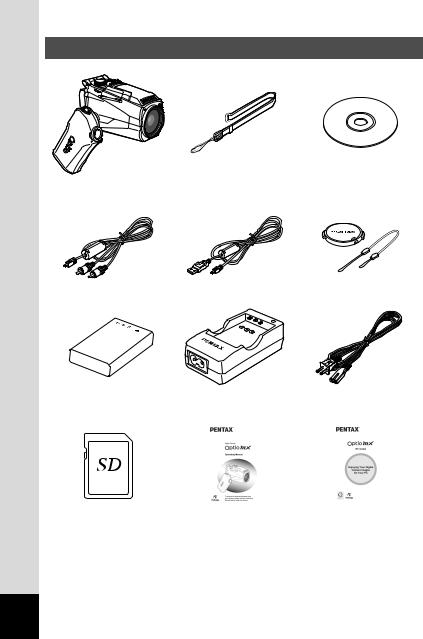
Checking the Contents of the Package
Camera |
Strap |
Software (CD-ROM) |
Optio MX |
O-ST17 ( ) |
S-SW17 |
AV cable I-AVC7 ( ) |
USB cable I-USB17 ( ) |
Lens cap/Cap holder |
Lithium-ion battery D-LI7 |
Battery charger |
AC plug cord |
||
Rechargeable ( ) |
|
D-BC7 ( ) |
D-CO2 ( ) |
|
|
|
|
|
|
|
|
|
|
|
SD Memory Card |
Operating Manual |
Operating Manual |
(16 MB) |
(this manual) |
(PC Guide) |
•Items marked with an asterisk ( ) are also available as optional accessories. For other optional accessories, refer to “Optional Accessories” (p.133).
•Type of AC plug cord
D-CO2A Australia/D-CO2B United Kingdom/D-CO2E Europe/D-CO2H Hong Kong/D-CO2J Japan/D-CO2K Korea/D-CO2U North America, Canada
10
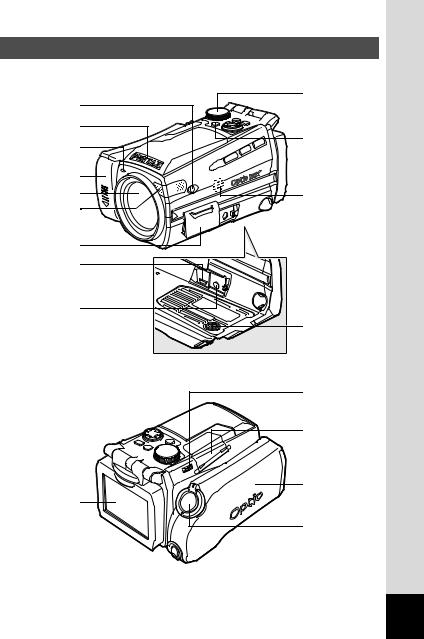
Names of Parts
Front
fbutton
Flash
Self-timer lamp
Battery cover
Lens
Microphone
Terminal cover
PC/AV terminal
DC input terminal
Back
Flexible LCD
monitor
Mode dial
Power switch
Speaker
 Strap lug
Strap lug
Tripod socket
SD Memory
Card cover lever
SD Memory
Card cover
Grip
Shutter release button
11
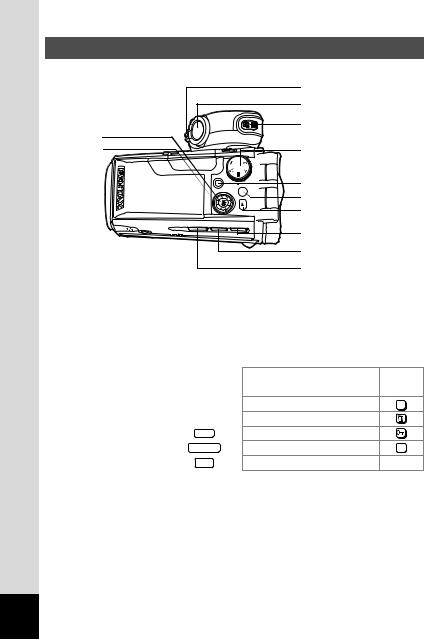
Names of Operating Parts
|
Zoom/w/x/f/y lever |
|
Shutter release button |
OK button |
C button |
|
|
Four-way |
Mode dial |
controller |
|
(2345) |
Power switch |
|
|
|
MENU button |
|
Q button |
|
)/ibutton |
|
m/gbutton |
|
b/Zbutton |
Guide Indications
A guide to available button operations appears on the LCD monitor during operation.
The buttons are indicated as shown below.
Four-way controller (2) |
2 |
Four-way controller (3) |
3 |
Four-way controller (4) |
4 |
Four-way controller (5) |
5 |
MENU button |
MENU |
Shutter release button |
SHUTTER |
Q button |
PLAY |
Zoom/f/y lever |
|
When trimming an image |
y |
DPOF button |
DP |
ibutton |
|
Zbutton |
|
OK button |
OK |
C button |
C |
12

Getting Started
Attaching the Strap
Cap holder
Attach the cap holder to the lens cap and thread the cord onto the camera strap. Remove the lens cap by pressing the tabs on either side of the cap.
1 Attach the strap to the camera.
Pass the narrow end of the strap through the strap lug and pass the other end through the loop. Do not tighten the strap until the
cap holder has been attached.
2 Attach the cap holder to the lens
cap.
Pass the short end of the cap holder through the hole in the lens cap.
3 Attach the cap holder to the camera strap as shown.
Pass the lens cap through the loop and tighten the cap holder and camera strap.
1 GettingStarted
13
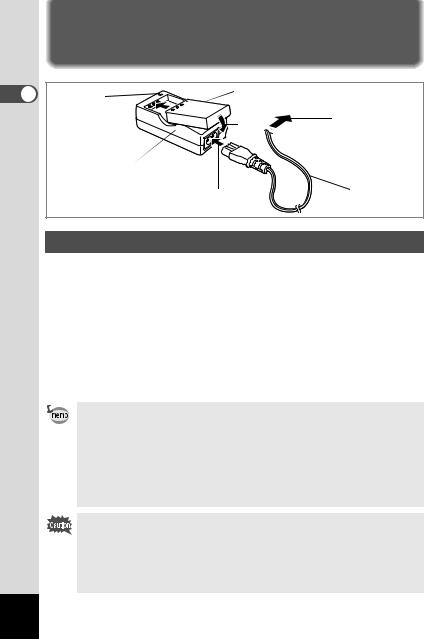
1 GettingStarted
Powering the Camera
Charging |
Battery |
To power outlet |
indicator |
|
|
|
3 |
2 |
|
|
|
Battery charger |
|
|
1 |
|
AC plug cord |
Charging the Battery
When using the camera for the first time or when the [Battery depleted.] message is displayed, charge the battery.
1 Connect the AC plug cord to the battery charger. 2 Plug the AC plug cord into the power outlet.
3 Place the battery in the charger with the label facing up.
The charging indicator lights red while the battery is charging and changes to green when charging is completed.
4 When charging is completed, remove the battery from the battery charger.
•The time required for full charge is about 180 minutes maximum. The appropriate ambient temperature range for charging the battery is 0°C-40°C (32°F to 104°F).
•The charging time may vary depending on the ambient temperature and charging conditions.
•When the battery reaches the end of its service life, the time that the camera can be operated becomes shorter even when the battery is fully charged. In this event, replace the battery.
•Always charge the battery after purchasing or when it has not been used for a long time.
•Use the Battery charger D-BC7 to charge the rechargeable Lithiumion battery D-LI7 only as the charger may overheat or be damaged.
•If the battery is inserted correctly but the charging indicator fails to light, the battery may be faulty. Replace with a new battery.
14
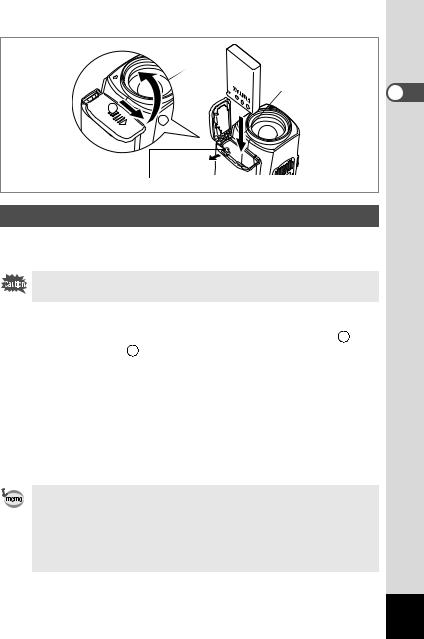
1
2
1
2
Battery lock lever |
(when using a D-LI7 battery) |
Installing the Battery
Insert the battery in the camera. Use one D-LI7 rechargeable lithium-ion battery.
AA batteries or AA rechargeable batteries cannot be used in this camera.
1 Open the battery cover on the end of the grip.
Slide the battery cover in the direction indicated by the arrow 1 and flip the cover open 2 .
2 Insert the battery with the 2 symbol facing toward the battery lock lever.
Push the battery in until the battery lock lever clicks.
3 Close the battery cover and slide it back into place to lock it.
Remove the battery by pressing the battery lock lever outward to release the lock.
•If you intend to use the camera continuously for a long period, use of the AC adapter D-AC7 (optional) is recommended. (p.134)
•The D-LI7 lithium-ion battery cannot be recharged in the camera.
•CR-V3 battery can be used but camera performance may deteriorate at low temperatures. Use the D-LI7 lithium-ion battery when using the camera at low temperatures.
1 GettingStarted
15

1 GettingStarted
•Insert the battery correctly. If the battery is incorrectly oriented, malfunction may result.
•Do not open the battery cover or remove the battery when the camera is turned on.
•If you do not intend to use the camera for a long time, remove the battery to avoid the risk of leakage.
•If the camera is left without the battery for a long time, the date and time may be reset. If this happens, follow the procedure in “Setting the Date and Time” (p.28).
•Image Storage Capacity, Recording Time and Playback Time (at 23°C, LCD monitor on with fully charged battery)
The image storage capacity, recording time and playback time for each type of battery are shown below.
Battery Type |
Image Storage Capacity |
Recording Time |
Playback Time |
|
(using the flash for 50% of shots) |
||||
|
|
|
||
D-LI7 |
Approx. 200 pictures |
Approx. 100 min. |
Approx. 200 min. |
•The still picture storage capacity is based on measuring conditions in accordance with CIPA standards and the movie recording time and playback time are based on PENTAX measuring conditions. Some deviation from the above figures may occur in actual use depending on shooting mode and shooting conditions.
• In general, battery performance temporarily deteriorates as the temperature decreases. When using the camera in a cold environment, keep it warm by putting it in your pocket or inside your coat. Battery performance that has deteriorated due to low temperature will be restored when the battery is returned to room temperature.
•Be sure to take a spare battery with you when traveling abroad or to a cold region, or if you intend to take a lot of pictures.
•Battery Level Indicator
You can check the battery level by the # symbol on the LCD monitor.
# (lit green) |
: Adequate power remains. |
↓ |
|
$ (lit yellow) |
: Battery is running very low. |
↓ |
|
% (lit red) |
: Battery is exhausted. |
↓ |
|
[Battery depleted] |
: The camera will turn off after this message appears. |
|
|
16
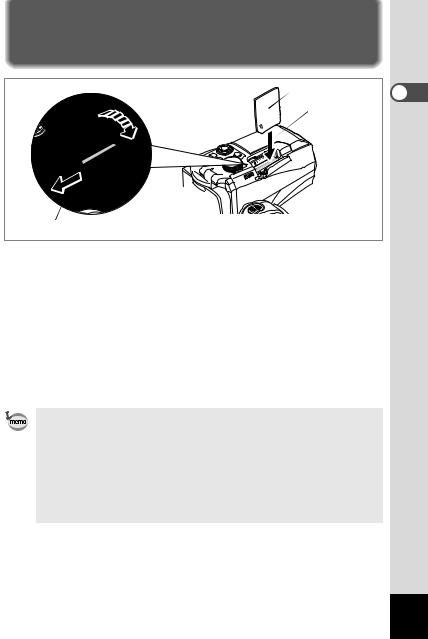
Installing the SD Memory Card
SD Memory Card |
1 |
2 |
Started Getting |
|
|
1 |
|
This camera uses an SD Memory Card to record captured images. Make sure that the camera is turned off before inserting or removing the SD Memory Card.
1 Push the card cover lever toward the LCD monitor.
The card cover opens.
2 Insert the SD Memory Card so the label is on the grip side and push the card in until it clicks.
3 Close the card cover.
To remove the card, press the card in to eject it and pull it out.
•The image storage capacity varies depending on the capacity of the SD Memory Card and the selected number of recorded pixels and quality level. (1p.19)
•The power switch lamp blinks while the SD Memory Card is being accessed (data is being recorded or accessed).
•Use a high-speed type SD Memory Card (10MB/S) for recording movies. If a standard-speed card (2MB/S) is used, [Stop] may appear on the LCD monitor and recording may be terminated.
17

1 GettingStarted
Precautions When Using an SD Memory Card
•The SD Memory Card is equipped with a write-protect switch. Setting the switch to LOCK protects the existing data by prohibiting recording of new data, deletion of existing data or formatting of the card.
oappears on the LCD monitor when the card is write-protected.
•Care should be taken if you remove the SD Memory Card immediately after using the camera, as the card may be hot.
•Do not remove the SD Memory Card or turn the camera off while data is being recorded on the card, images or sound are being played back, or the camera is connected to a PC with the USB cable, as this may cause the data to be lost or the card to be damaged.
•Do not bend the SD Memory Card or subject it to violent impact. Keep it away from water and store away from high temperature.
•Be sure to format unused cards or cards that have been used on another camera. Refer to “Formatting an SD Memory Card” (p.120) for instructions on formatting.
•Do not remove the SD Memory Card during formatting as this may damage the card and render it unusable.
•The data on the SD Memory Card may be deleted in the following circumstances. PENTAX does not accept any liability for data that is deleted
(1)when the SD Memory Card is mishandled by the user.
(2)when the SD Memory Card is exposed to static electricity or electrical interference.
(3)when the card has not been used for a long time.
(4)when the card is ejected, the AC adapter is disconnected or the battery is removed while the data on the card is being recorded or accessed.
•The SD Memory Card has a limited service life. If it is not used for a long time, the data on the card may become unreadable. Be sure to make a backup of important data on a PC.
•Avoid using or storing the card where it may be exposed to static electricity or electrical interference.
•Avoid using or storing the card in direct sunlight or where it may be exposed to rapid changes in temperature or to condensation.
•When using an SD Memory Card with a slow recording speed, recording may stop while you are taking movies even when there is adequate space in the memory, or shooting and playback may take a long time.
•For information on compatible memory cards, visit the PENTAX website or contact your nearest PENTAX customer service center.
18

Recorded Pixels and Quality Level for Still Pictures
Choose the number of recorded pixels and quality level best suited to your purpose.
Higher quality levels and numbers of recorded pixels produce clearer images for printing, but the resulting increase in data volume reduces the total number of pictures that can be taken.
Choose the appropriate number of recorded pixels and quality level for still pictures on the [ARec. Mode] menu.
Selecting the Recorded Pixels 1p.70
Selecting the Quality Level 1p.71
Appropriate Number of Recorded Pixels According to Use
2048 |
(2048×1536) |
Suitable for printing on A4 paper |
1600 |
(1600×1200) |
Suitable for printing on paper slightly larger than a postcard |
1024 |
(1024×768 ) |
Suitable for printing on postcards |
640 |
( 640×480 ) |
Suitable for attaching to e-mails or creating websites |
The default setting is 2048×1536.
Appropriate Quality Level According to Use
C |
Best |
Lowest compression rate. Suitable for photo prints. |
|
D |
Better |
Standard compression rate. Suitable for viewing the image |
|
on a computer screen. |
|||
|
|
||
E |
Good |
Highest compression rate. Suitable for attaching to e-mails |
|
or creating websites. |
|||
|
|
||
The default setting is D. |
|||
Recorded Pixels, Quality Level and Recordable Images
|
|
C |
D |
E |
|
|
Best |
Better |
Good |
2048 |
(2048×1536) |
29 pictures |
55 pictures |
81 pictures |
1600 |
(1600×1200) |
50 pictures |
87 pictures |
120 pictures |
1024 |
(1024×768 ) |
109 pictures |
202 pictures |
257 pictures |
640 |
( 640×480 ) |
241 pictures |
386 pictures |
483 pictures |
•The above table shows the approximate number of images when using a 64MB SD Memory Card.
•The above figures are based on measuring conditions in accordance with CIPA standards. It may vary depending on the subject, shooting conditions, shooting mode, SD Memory Card, etc.
1 GettingStarted
19
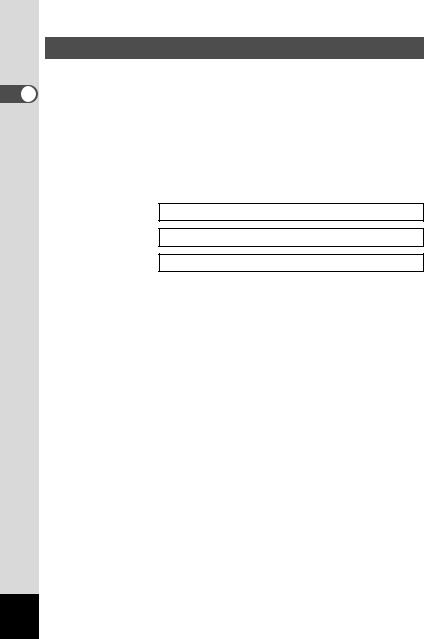
1 GettingStarted
Recorded Pixels and Quality Level for Movies
Choose the number of recorded pixels and quality level best suited to your purpose.
The number of recorded pixels indicates the image resolution. Larger sizes produce clearer images, but results in larger filesizes.
The frame rate indicates the number of images that are displayed per second. Higher numbers produce smoother motion, but also results in larger filesizes.
Choose the appropriate number of recorded pixels and quality level for movies on the [CRec. Mode] menu.
Selecting the Recorded Pixels for Movies 1p.89
Selecting the Quality Level for Movies 1p.90
Selecting the Frame Rate 1p.91
Appropriate Number of Recorded Pixels According to Use
640 (640×480) |
VGA size. Produces high quality movies for viewing on a TV. |
|
Large filesize. |
||
|
||
320 (320×240) |
Suitable for viewing on a PC. |
|
160 (160×120) |
Low quality, but small filesize. |
The default setting is 640×480.
Appropriate Quality Level According to Use
C |
Best |
Produces high quality movies for viewing on a TV. |
D |
Better |
Suitable for sending by high-speed Internet circuit. |
E |
Good |
Suitable for attaching to e-mails. |
The default setting is Best. |
||
Appropriate Frame Rate According to Use |
(frames/sec.) |
|
|
|
|
30fps |
Produces high quality images for viewing on a TV. |
|
15fps |
Suitable for viewing on a PC or on the camera. |
|
The default setting is 30 frames/sec. (fps).
20

Recorded Pixels, Quality Level and Recording Time
|
|
|
Frame rate: 30fps (15fps) |
||
|
|
|
|
|
|
|
C |
D |
E |
Sound |
|
|
Best |
Better |
Good |
||
|
|
||||
640 (640×480) |
2.5 min. |
4 min. |
5 min. |
|
|
(5 min.) |
(7 min.) |
(9 min.) |
|
||
|
|
||||
320 (320×240) |
6 min. |
9 min. |
16 min. |
4 hr. 22 min. |
|
(11 min.) |
(16 min.) |
(25 min.) |
|||
|
|
||||
160 (160×120) |
16 min. |
20 min. |
31 min. |
|
|
(25 min.) |
(31 min.) |
(42 min.) |
|
||
|
|
||||
•The above table shows the approximate recording time when using a 64MB SD Memory Card.
•The above table is based on standard shooting conditions specified by PENTAX and may vary depending on the subject, shooting conditions, SD Memory Card, etc.
1 GettingStarted
21
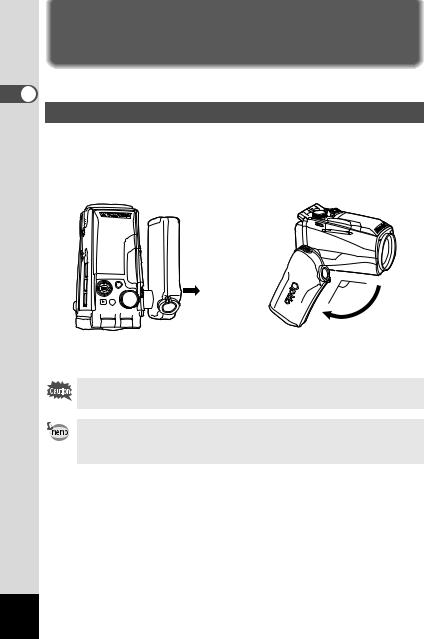
1 GettingStarted
Operating the Camera Parts
The following is an explanation of how to operate the camera parts.
Using the Grip
Pull the grip out from the camera and rotate it in the direction indicated by the arrow.
Adjust the grip to a comfortable position for holding the camera (about 120°).
|
about 120° |
Take hold of the grip near the |
Rotate the grip to the |
hinge and extend it. |
desired position. |
You can rotate the grip to a maximum of 180 degrees to the lens. Do not apply excessive force to the grip.
•You can use the camera without extending the grip.
•For greater stability, leave the grip unextended when attaching the camera to a tripod.
22
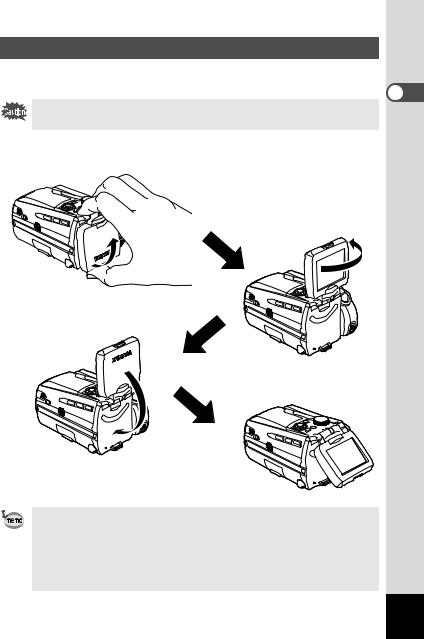
Opening the LCD Monitor
You can swivel the LCD monitor 210 degrees vertically and 180 degrees horizontally to ensure easy viewing from different angles.
Do not apply excessive force when swiveling the LCD monitor.
Lift
Open the LCD monitor from the bottom.
Swivel
Swivel the LCD monitor anticlockwise.
Lower
Lower the LCD monitor into the viewing position.
•When you aim the LCD monitor at yourself to take a picture of yourself, the image you see in the LCD monitor will be a mirror image, but the resulting picture will be the view seen through the lens.
•To protect the LCD monitor when the camera is not in use, return the LCD monitor to the position it was in when the camera was purchased.
1 GettingStarted
23
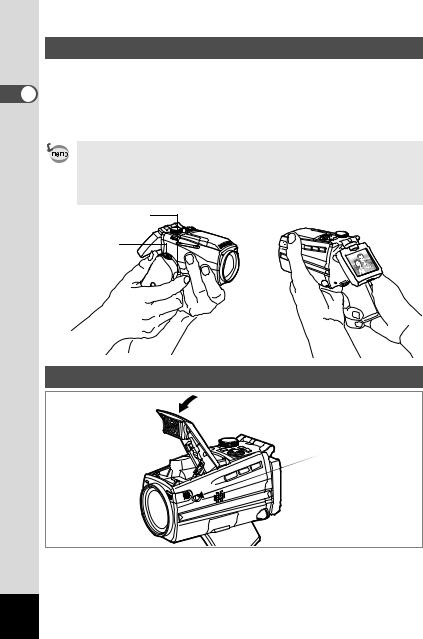
1 GettingStarted
Holding the Camera
Holding the camera in your right hand by the grip, operate the shutter release button and the Zoom/w/x lever with your index finger and the C button with your thumb.
To prevent camera shake when using the zoom or taking movies, hold the camera steady with your left hand. Position the LCD monitor at an angle of 45 degrees for easy viewing.
• When recording movies, sound is recorded at the same time. Be careful not to cover the microphone or the holes at the side of the microphone with your finger.
•You are recommended to use a tripod to prevent camera shake when taking pictures at a high magnification rate.
Shutter release button
Zoom/w/x lever
C button
Using the Flash
fbutton
1 Press the fbutton on the side of the camera.
The flash pops up.
Press the area around the PENTAX logo on the cover softly to close the flash.
24
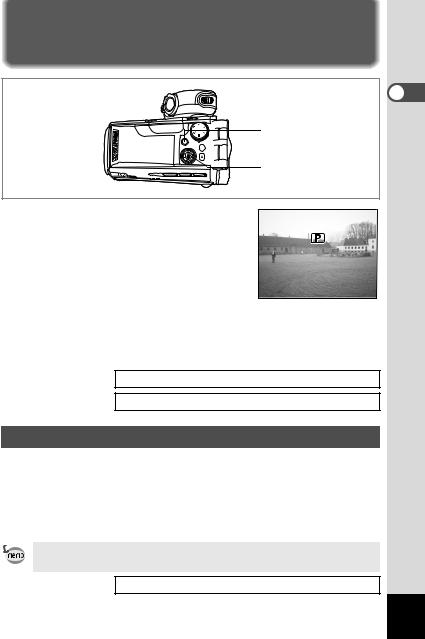
Turning the Camera On and Off
|
Power switch |
|
OK button |
1 Press the power switch. |
|
The camera turns on and the power switch |
|
lights green. |
|
The shooting mode icon and name appear |
Program |
for one second. |
|
If the Initial Settings screen or Date Adjust |
|
screen appears when you turn the camera |
|
on, follow the procedure on page 27 to set |
|
the display language and/or current date and time.
2 Press the power switch again.
The camera turns off and the power switch turns light off.
Taking Still Pictures 1p.46
Recording and Playback 1p.65
Playback Only Mode
Use this mode when you want to play back pictures one after another. Pressing the shutter release button does not change the mode to the Capture mode.
1 Press the power switch while pressing the Q button.
The camera turns on in Playback Only mode.
To switch from Playback Only mode to Capture mode, turn the camera off, then turn it on again.
Playing Back Still Pictures 1p.96
1 GettingStarted
25

1 GettingStarted
Power switch
Voice Recording Only Mode
This mode lets you use the camera as a voice recorder.
Voice Recording Only mode is exclusively for recording sound; you cannot take still pictures or movies in this mode.
1 Set the mode dial to O and press the power switch.
The camera turns on in Voice Recording Only mode.
To switch to capture status, set the mode dial to any mode other than O.
Recording Sound 1p.92
Voice Recording Mode 1p.40
26
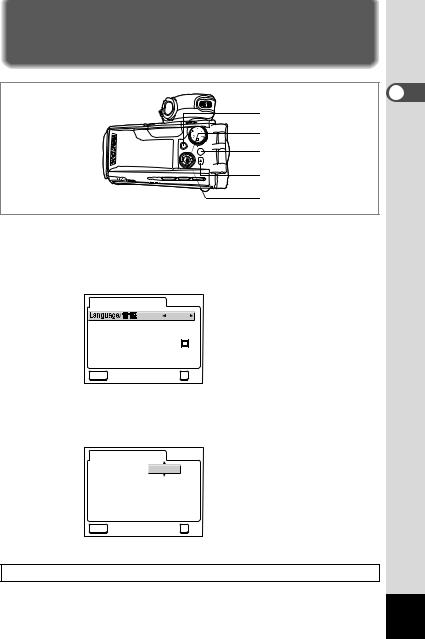
Initial Settings
Power switch
OK button
MENU button
Q button
Four-way controller
If the Initial Settings screen or Date Adjust screen appears when you turn the camera on, follow the procedure below to set the display language and/or current date and time.
If the Initial Settings screen appears
Initial Settings
|
English |
City |
NYC |
DST |
|
Video Out |
NTSC |
MENU Exit |
OK OK |
1p.28 “Setting the Display Language” “Setting the Date
and Time”
If the Date Adjust screen appears
Date Adjust |
|
Date Style |
mm/dd/yy 24h |
01 / |
01 / 2004 |
|
00 : 00 |
MENU Exit |
OK OK |
1p.28 “Setting the Date and Time”
If neither screen appears, setting is not required.
1 GettingStarted
27
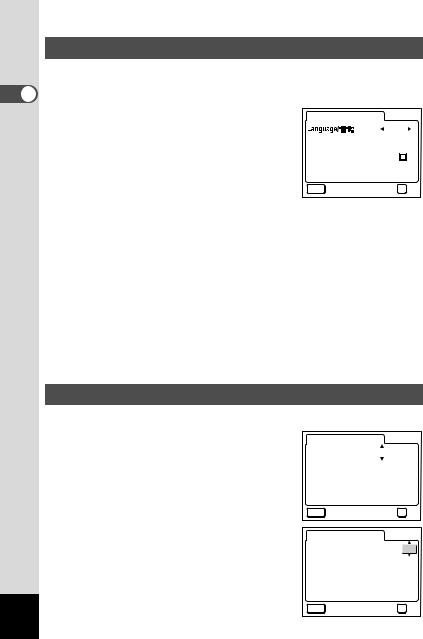
Setting the Display Language
|
You can choose the language in which the menus, error messages, etc. |
||||||
|
are displayed from the following: English, French, German, Spanish, |
||||||
1 |
Italian, Russian, Chinese, Korean and Japanese. |
|
|
|
|
|
|
1 |
Use the four-way controller (45) |
Initial Settings |
|
|
|
|
|
Getting |
2 |
Press the four-way controller (3). |
DSTCity |
NYC |
|||
|
|
to choose the display language. |
|
English |
|
||
Started |
3 |
The default setting is English. |
|
|
|
|
|
Use the four-way controller (45) |
MENU Exit |
|
|
|
|||
OK OK |
|||||||
|
|
The screen for setting the city appears. |
Video Out |
NTSC |
|||
|
|
|
|||||
|
|
to choose the desired city (Home |
|
|
|
|
|
|
4 |
Town). |
|
|
|
|
|
|
Press the four-way controller (3). |
|
|
|
|
|
|
|
5 |
The screen for setting DST (Daylight Saving Time) appears. |
|
|
|
|
|
|
Use the four-way controller (45) to select O(On) or |
||||||
|
6 |
P(Off). |
|
|
|
|
|
|
Press the four-way controller (3). |
|
|
|
|
|
|
|
7 |
The screen for setting the video output format appears. |
|
|
|
|
|
|
Use the four-way controller (45) to choose NTSC or |
||||||
|
8 |
PAL. |
|
|
|
|
|
|
Press the OK button. |
|
|
|
|
|
|
The Date Adjust screen appears.
Setting the Date and Time
Set the current date and time and the display style.
1 Use the four-way controller (23) |
Date Adjust |
||
to choose the date and time |
|
|
|
Date Style |
mm/dd/yy |
24h |
|
display style. |
|
|
|
2 Press the four-way controller (5).
2and 3appear above and below [24h].
3 Use the four-way controller (23) to select [24h] (24-hour display) or
28 |
[12h] (12-hour display). |
|
01 / |
01 / 2004 |
|
00 : 00 |
MENU Exit |
OK OK |
Date Adjust |
|
Date Style |
mm/dd/yy 24h |
2004 / |
01 / 01 |
|
00 : 00 |
MENU Exit |
OK OK |
